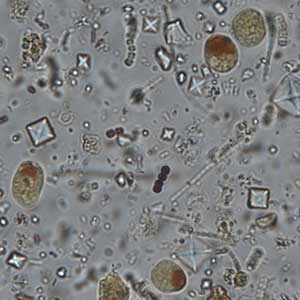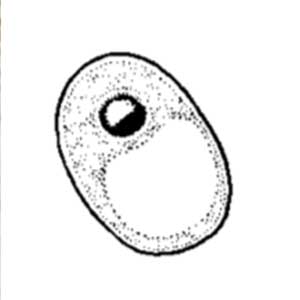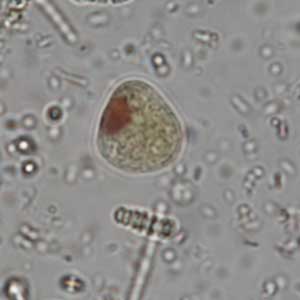Iodamoeba butschlii is an amoeba of the cecum and colon of primates.
Epidemiology
Iodamoeba butschlii is a cosmopolitan parasite which is non-pathogenic to non-human primates, their definitive host. They have been described in both Old and New World Monkeys, as well as in Apes, namely in macaques (Macaca spp.), red colobus monkeys (Piliocolobus tephrosceles), common patas monkeys (Erythrocebus patas), mangabeys (Cercocebus and Lophocebus spp.), capuchin monkeys (Cebus and Sapajus spp.), vervet monkeys (Chlorocebus aethiops), chimpanzees (Pan spp.) and gorillas (Gorilla gorilla) (Cogswell, 2007; Gonzalez-Moreno et al., 2020; N’da et al., 2021).
Description
Iodamoeba butschlii cysts are oval and measure 5 to 20 µm long. They contain a medium-to-large-sized round nucleus with a large nucleolus, and a voluminous, eccentric iodophilic vacuole which stains brown with Lugol (Euzéby, 2008).
Differential diagnosis
Iodamoeba butschlii are generally easy to identify with Lugol stain. Differential diagnosis includes small to medium-sized amoebas, including immature forms of Entamoeba histolytica, which can also contain an iodophilic vacuole (Euzéby, 2008). However, these immature cysts are rounded and contain one to four nuclei. Moreover, their iodophilic vacuole is normally less stained with Lugol than the one of I. butschlii. Finally, they contain crystalloid bodies which are absent in I. butschlii cysts (Euzéby, 2008). Specific stains like trichrome or iron hematoxylin can facilitate the identification of these details.
Clinical significance
Iodamoeba butschlii is not pathogenic for its hosts (Cogswell, 2007).
Prophylaxis and treatment
As a non-pathogenic parasite, infection by Iodamoeba buschlii does not require treatment. Nevertheless, hygienic measures need to be taken in case of diagnosis in a captive setting.







